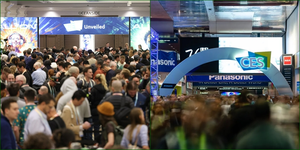New Delhi: The Consumer Eectronics Show (CES) 2024, the global mega trade show, is when the tech industry rings in the New Year. Amid hundreds of new innovations, though, only a few live up to the hype and reach the masses to make a notable change in their daily lives.
The annual event drew more than 130,000 attendees and over 4,000 exhibitors from more than 150 countries and regions, including over 1,200 startups, according to the Consumer Technology Association (CTA), organiser of the CES.
A blend of cutting-edge technologies, new launches and quirky gadgets swarmed the show floor, showcasing the latest trends and innovation in the consumer electronics industries.
This time, amid a wave of laptops, tablets, handheld devices, mixed reality (MR) headsets, AI-driven cars and smart home gadgets, artificial intelligence (AI) took the centre-stage and AI-assisted innovations caught the most eyeballs.
From transparent TVs to adorable robots, from next-gen EVs and drones to cool health-tech innovations, the trade show brought something for all.
The opening day of ‘CES 2024’ witnessed a flurry of product launches, notably Sony’s surprising entry into the mixed reality (MR) headset arena.
Tailored for spatial content creators, the headset is anticipated to hit the market later this year.
Simultaneously, Apple revealed that its flagship spatial computing headset, the Vision Pro, showcased last year, will be available for purchase in early February.
“As Apple and Sony gear up for a tight tech competition in the spatial computing realm, keeping an eye on the upcoming moves of established contenders in this space, namely Microsoft and Meta Platforms, becomes an intriguing prospect,” said Sourabh Nyalkalkar, Practice Head of Innovation Products at GlobalData.
Samsung shared its vision for how AI technology will enable people to experience their devices more intuitively and conveniently than ever before.
Jong-Hee (JH) Han, Vice Chairman, CEO and Head of Samsung’s Device eXperience (DX) Division, described how AI will enable connected technologies to improve people’s daily lives while always remaining nonintrusive and “in the background”.
“With the emergence of artificial intelligence, smarter, better experiences will redefine how we live,” Han said. “Samsung’s broad portfolio of powerful devices, along with the pursuit of open collaboration, will help bring AI and hyper-connectivity to all.”
Several tech companies took the opportunity to unveil their cutting-edge innovations, offering a glimpse into the future of AI-driven robotics.
German automaker Volkswagen announced plans to bring an AI chatbot called ChatGPT into its cars, integrated into its IDA voice assistant.
Sony showcased an upgraded EV prototype car called Afeela, a concept electric vehicle that features a huge dashboard display and autonomous driving capabilities.
Called Media Bar, the bumper screen can display information like a warning sign, birthday greetings and logos from popular movie and game titles.
Hyundai Motor Group took the lead at the global event, unveiling the prototype of its new air taxi model, as it steps up efforts to make inroads into the global electric flying taxi market.
Supernal, a US-based air taxi unit of Hyundai, showcased the product concept of the S-A2, an electric vertical takeoff and landing (eVTOL).
Meanwhile, Pivotal, backed by Google co-founder Larry Page, started sales of its lightweight electric personal Helix aircraft, which does not require a pilot’s license to be able to fly in the US.
As customers continue to desire higher-definition screens for their homes, TV manufacturers are using the latest visual technologies to create more advanced displays.
Samsung showcased its leading ‘MICRO LED’ display to expand how users enjoy visual content. The transparent crystal-clear, glass-like display revolutionised the viewing experience and attracted the attention of global consumers.
Its arch rival LG was not far behind. It unveiled the world’s first wireless transparent OLED TV at ‘CES 2024’.
Maintaining its 77-inch screen size, OLED T and its innovative transparent display seamlessly harmonises with its environment. Practically invisible when turned off, it blends into the environment and frees users from the long-standing problem of what to do with the ‘big black screen.’
The TV’s beautiful see-through screen also helps to make one’s space feel larger, providing a sense of openness.
Overall, the trade show brought cheers for many, heralding an era of AI into almost everything gizmo and gadget around us.
–IANS


Comments are closed.